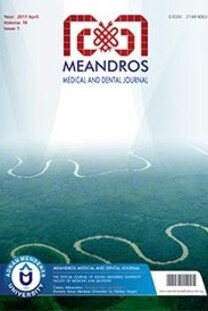Yüksek Yağ İçerikli Diyetle Beslenmiş Sıçanların Karaciğer Dokularının Histokimyasal ve Biyokimyasal İncelenmesi
Biochemical and Histopathological Investigation of Liver Tissues on High Fat Diet Fed Rats
___
- 1. Adams LA, Angulo P, Lindor KD. Nonalcoholic fatty liver disease. CMAJ 2005; 172: 899-905.
- 2. Koteish A, Diehl AM. Animal models of steatosis. Semin Liver Dis 2001; 21: 89-104.
- 3. Iizuka K, Bruick RK, Liang G, Horton JD, Uyeda K. Deficiency of carbohydrate response element-binding protein (ChREBP) reduces lipogenesis as well as glycolysis. Proc Natl Acad Sci U S A 2004; 101: 7281-6.
- 4. Kulinski A, Vance DE, Vance JE. A choline-deficient diet in mice inhibits neither the CDP-choline pathway for phosphatidylcholine synthesis in hepatocytes nor apolipoprotein B secretion. J Biol Chem 2004; 279: 23916-24.
- 5. Li S, Liao X, Meng F, Wang Y, Sun Z, Guo F, et al. Therapeutic role of ursolic acid on ameliorating hepatic steatosis and improving metabolic disorders in high-fat diet-induced non-alcoholic fatty liver disease rats. PLoS One 2014; 9: e86724.
- 6. Brunt EM, Janney CG, Di Bisceglie AM, Neuschwander-Tetri BA, Bacon BR. Nonalcoholic steatohepatitis: a proposal for grading and staging the histological lesions. Am J Gastroenterol 1999; 94: 2467-74.
- 7. Sun Y, Oberley LW, Li Y. A simple method for clinical assay of superoxide dismutase. Clin Chem 1988; 34: 497-500.
- 8. Aebi H. Catalase in vitro. Methods Enzymol 1984; 105: 121-6.
- 9. Tietze F. Enzymic method for quantitative determination of nanogram amounts of total and oxidized glutathione: applications to mammalian blood and other tissues. Anal Biochem 1969; 27: 502-22.
- 10. Ohkawa H, Ohishi N, Yagi K. Assay for lipid peroxides in animal tissues by thiobarbituric acid reaction. Anal Biochem 1979; 95: 351-8.
- 11. Sumida Y, Yoneda M. Current and future pharmacological therapies for NAFLD/NASH. J Gastroenterol 2018; 53: 362-76.
- 12. Jahn D, Kircher S, Hermanns HM, Geier A. Animal models of NAFLD from a hepatologist's point of view. Biochim Biophys Acta Mol Basis Dis. 2019;943-953.
- 13. Chen XY, Cai CZ, Yu ML, Feng ZM, Zhang YW, Liu PH, et al. LB100 ameliorates nonalcoholic fatty liver disease via the AMPK/Sirt1 pathway. World J Gastroenterol 2019; 25: 6607-18.
- 14. Friedman SL, Neuschwander-Tetri BA, Rinella M, Sanyal AJ. Mechanisms of NAFLD development and therapeutic strategies. Nat Med 2018; 24: 908-22.
- 15. Lieber CS, Leo MA, Mak KM, Xu Y, Cao Q, Ren C, et al. Model of nonalcoholic steatohepatitis. Am J Clin Nutr 2004; 79: 502-9.
- 16. Wu Y, Wang C, Sun H, LeRoith D, Yakar S. High-efficient FLPo deleter mice in C57BL/6J background. PLoS One 2009; 4: e8054.
- 17. Park HJ, Lee JY, Chung MY, Park YK, Bower AM, Koo SI, et al. Green tea extract suppresses NFκB activation and inflammatory responses in diet-induced obese rats with nonalcoholic steatohepatitis. J Nutr 2012; 142: 57-63.
- 18. Chen X, Li L, Liu X, Luo R, Liao G, Li L, et al. Oleic acid protects saturated fatty acid mediated lipotoxicity in hepatocytes and rat of non-alcoholic steatohepatitis. Life Sci 2018; 203: 291-304.
- 19. Gårdebjer EM, Cuffe JSM, Ward LC, Steane S, Anderson ST, Dorey ES, et al. Effects of periconceptional maternal alcohol intake and a postnatal high-fat diet on obesity and liver disease in male and female rat offspring. Am J Physiol Endocrinol Metab 2018; 315: E694-704.
- 20. Wang Z, Li S, Wang R, Guo L, Xu D, Zhang T, et al. The protective effects of the β3 adrenergic receptor agonist BRL37344 against liver steatosis and inflammation in a rat model of high-fat dietinduced nonalcoholic fatty liver disease (NAFLD). Mol Med 2020; 26: 54.
- 21. Xie X, Yan D, Li H, Zhu Q, Li J, Fang YP, et al. Enhancement of Adiponectin Ameliorates Nonalcoholic Fatty Liver Disease via Inhibition of FoxO1 in Type I Diabetic Rats. J Diabetes Res 2018; 2018: 6254340.
- 22. Yang JM, Sun Y, Wang M, Zhang XL, Zhang SJ, Gao YS, et al. Regulatory effect of a Chinese herbal medicine formula on nonalcoholic fatty liver disease. World J Gastroenterol 2019; 25: 5105-19.
- 23. Ding X, Jian T, Li J, Lv H, Tong B, Li J, et al. Chicoric Acid Ameliorates Nonalcoholic Fatty Liver Disease via the AMPK/Nrf2/NFκB Signaling Pathway and Restores Gut Microbiota in High-Fat-DietFed Mice. Oxid Med Cell Longev 2020; 2020: 9734560.
- 24. Yi HW, Zhu XX, Huang XL, Lai YZ, Tang Y. Selenium-enriched Bifidobacterium longum protected alcohol and high fat diet induced hepatic injury in mice. Chin J Nat Med 2020; 18: 169-77.
- 25. Echeverría F, Valenzuela R, Bustamante A, Álvarez D, Ortiz M, Soto-Alarcon SA, et al. Attenuation of High-Fat Diet-Induced Rat Liver Oxidative Stress and Steatosis by Combined Hydroxytyrosol- (HT-) Eicosapentaenoic Acid Supplementation Mainly Relies on HT. Oxid Med Cell Longev 2018; 2018: 5109503.
- ISSN: 2149-9063
- Yayın Aralığı: 4
- Başlangıç: 2000
- Yayıncı: Aydın Adnan Menderes Üniversitesi
Farklı Uygulama Prosedürleri Kendinden Bağlanabilen Restoratif Materyallerin Sertliğini Etkiler mi?
Alparslan GÖKÇİMEN, Tuncay KULOĞLU, Yurdun KUYUCUSU, Sait POLAT, Tuğba ÇELİK SAMANCI, Murat BOYACIOĞLU
Gülbahar USTAOĞLU, Ülkü Mete URAL, Handan ANKARALI, Tuğçe PAKSOY
Türkçe Evcil Hayvan Tutum Ölçeğinin Geçerlik ve Güvenirliği
Musa Şamil AKYIL, Filiz ABACIGİL, Seyhan ÇİTLİK SARITAŞ, Rahşan ÇEVİK AKYIL, Ayşegül KAHRAMAN
Koledok Taşı için Ayaktan ERCP Güvenli midir?
Bülent ÖDEMİŞ, Hakan YILDIZ, İsmail TAŞKIRAN, Erkan PARLAK
Zeliha UĞUR AYDIN, Duygu GÖLLER BULUT
Sevda ERKAN, Kübra YARADANAKUL, Berza ŞEN YILMAZ, Ezgi Sunal AKTÜRK
Aslıhan BÜYÜKÖZTÜRK KARUL, Adem KESKİN
Dilek ÖZÇELİK SOBA, Yasemin ÖZDAMAR EROL, Burcu KAZACI, Çağrı İLHAN
